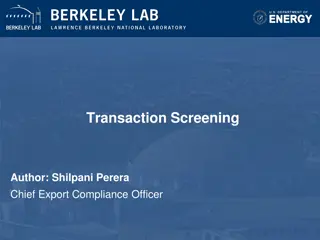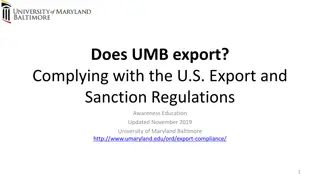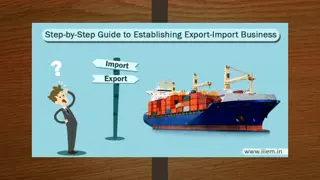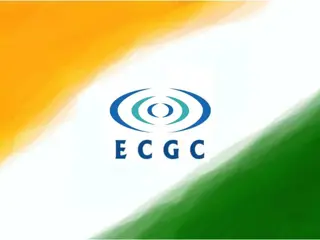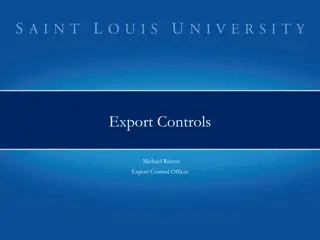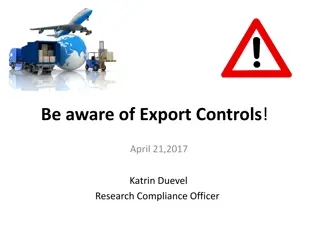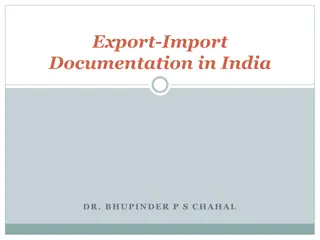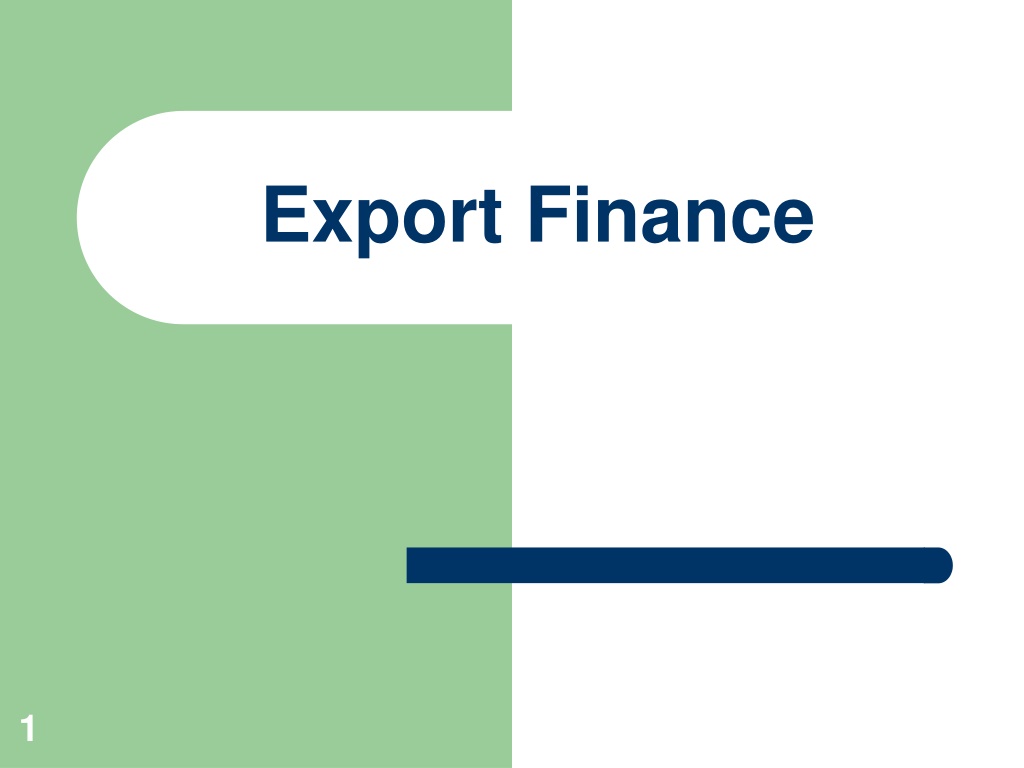
Understanding Export Finance and Credit Options
Learn about export finance essentials like pre-shipment and post-shipment credit, duty drawback advances, and foreign currency packing credit. Explore how banks support exporters in earning valuable foreign exchange.
Download Presentation

Please find below an Image/Link to download the presentation.
The content on the website is provided AS IS for your information and personal use only. It may not be sold, licensed, or shared on other websites without obtaining consent from the author. If you encounter any issues during the download, it is possible that the publisher has removed the file from their server.
You are allowed to download the files provided on this website for personal or commercial use, subject to the condition that they are used lawfully. All files are the property of their respective owners.
The content on the website is provided AS IS for your information and personal use only. It may not be sold, licensed, or shared on other websites without obtaining consent from the author.
E N D
Presentation Transcript
EXPORT FINANCE Exports earn valuable foreign exchange for the country Exports are a preferred sector, getting several concessions and benefits Banks (members of Foreign Exchange Dealers Association) should achieve a level of 12 % of net credit as export credit. Classified into 2 types: Pre shipment finance. Post shipment finance.
PRE SHIPMENT CREDIT Pre-shipment or Packing credit: is granted as a working capital advance. Objectives are: Procure raw materials. Carry out manufacturing process. Provide a secure warehouse for goods and raw materials. Process and pack the goods. Ship the goods to the buyer. Meet other financial cost of the business.
PRE SHIPMENT CREDIT Issued to exporters who have a valid Importer- Exporter Code (IEC) allotted by DGFT. Exporter should have an export order in his own name and should not be in the caution list of RBI. Goods to be exported should not fall under restricted category. Period of advance is 180 days Repayment is either out of export proceeds or by negotiation of bills under LC 4
PCFC- Foreign Currency Packing credit is available in two forms: Packing credit in Indian Rupees Packing Credit in foreign currency (PCFC). PCFC is self-liquidating; after shipment the borrower (exporter) submits bills for discounting and the account under the export order closes. The interest rate is linked to LIBOR. Sources of funds for banks for extending PCFC facility are forex balances available in EEFC (exchange earners foreign currency) , RFC (resident foreign currency) and NRFC (non-resident foreign currency) accounts. 1. 2.
Advances Against Duty Drawback Excise duty (customs, sales tax and others) on raw materials used in exports is refunded to exporters according to government entitlements. Banks can grant advances at concessional rates of interest on this entitlement for up to 90 days. Amount of advance is adjusted after receiving the drawback amount.
Post Shipment Credit Post shipment finance is provided to meet working capital requirements after the actual shipment of goods. It bridges the financial gap between the date of shipment and actual receipt of payment from overseas buyer thereof. Generally for export duties/taxes, advertisement, after sales service, fright and shipping expenses, marine insurance etc. 7
Post Shipment Credit Also called documentary credit. Documents required are: Commercial invoice Bill of Exchange Packing list Certificate of Origin Quality certificate Bill of Lading/ Airways bill Dock receipt 8
Post Shipment Credit- Types Export bills purchased/ discounted. Export bills negotiated. Advance against export bills sent for collection basis. 9
Export Bills Purchased / Discounted The finance or loan can be obtained by the exporter based on the bills of the purchase made by the importer or overseas company. Export bills (non-LC bills) are used in indisputable export transactions. These bills can be purchased (sight/demand bills) or can be discounted(usanse bills). Export Bills Rediscounted (EBR) account gets debited and is eventually liquidated out of the proceeds of bill payment by the overseas buyer. In the case of any default, the finance company (Bank) will compensate about 80% of the default amount. It is considered as post shipment finance. 10
BILL NEGOTIATION- Letter of Credit An LC is an undertaking by a bank (issuing bank) acting on behalf of a customer (applicant) to make payment to a third party (beneficiary) or to pay, accept or negotiate bills of exchange drawn by the beneficiary under the terms of the credit.
N 12
Banking considerations- LC LC is issued against collateral- FDs, property Bank charges fee for LC issuance Process based on the guidelines issued by ICC (International Chamber of Commerce). Correctness of LC- Name of seller, date, amount, product name, type, quantity etc. to be clear and precise. All banks deal in only documents and not the actual goods. 13
LC- Risk factor for banks Issuing bank faces the insolvency risk of the applicant (importer). In case of nonperformance by the exporter, when he is unable to meet his terms and conditions, the issuing banks do not honor the letter of credit. The negotiating bank faces the documentary risk where the issuing bank refuses to honor its commitment. This is non- reimbursement risk i.e. credit amount not received by issuing bank although it has already paid to its beneficiary (exporter). 14
ADVANTAGE OF LCS Provides assurance to both - the seller and the buyer by routing dealings through recognized banks Buyer/importer s bank on receiving the documents can scrutinize them and ensure that the they are in conformity with the agreed terms under the LC. Buyer has certainty of receiving the goods. Shows the solvency of buyer. Seller is assured of payment if he has complied with the agreed terms. Ensures compliance with statutory requirements obtention of import licence.
Bills sent for Collection Bill collection is a trade transaction in which the exporter hands over the task of collecting payment for goods supplied to his or her bank, which sends the shipping documents to the importer's bank together with payment instructions. A margin of 10 to 25% is stipulated in such cases. Generally availed when the assistance available under foreign bills purchased is exhausted; or When some export bills drawn under L/C have discrepancies; or Where it is a customary practice in the particular line of trade. 16
Factoring Factoring, receivables factoring or debtor financing, is when a company buys a debt or invoice from another company. Accounts receivable are discounted in order to allow the buyer to make a profit upon the settlement of the debt. Essentially factoring transfers the ownership of accounts to another party that then chases up the debt. It relieves the first party of a debt for less than the total amount providing them with working capital to continue trading. 17
Factoring - Process Debt purchase facility entered into between exporter and financer(bank). Financer becomes the loss payee of credit insurance. Notice of factoring provided to the importer. Goods shipped and importer invoiced by the exporter. Financer purchases invoice and pays 80% to the exporter. Importer pays to the financer and exporter receives balance amount. 1. 2. 3. 4. 5. 6. The factor (financer) charges the seller a service charge, as well as interest based on how long the factor must wait to receive payments from the debtor. 19
Deemed Export Finance "Deemed Exports" refers to those transactions in which the goods supplied do not leave the country and the payment for such supplies is received either in Indian rupees or in free foreign exchange. Example: Supply of goods to Export Oriented Units (EOUs) or Software Technology Parks (STPs) or Electronic Hardware Technology Parks (EHTPs) or Bio Technology Parks (BTP). Supply to projects funded by UN agencies. 20
Deemed Export Finance Export finance given to deemed exports i.e., in free trade zones at Mumbai, Chennai, Calcutta, Delhi, Cochin and Vizag, the suppliers of goods to foreign exporters are given finance. In these free trade zones, the value of the goods exported should be not less than 50% from the domestic market. Hence, the suppliers are provided finance under deemed export finance. 21
Finance against Deferred Payment Export Contracts for export of goods and services against payment to be secured partly or fully beyond 180 days are treated as deferred payment exports. Enable realization of export proceeds over a period exceeding six months. Generally in case of civil and engineering goods and services, technical and consultancy services. 22
BANK GUARANTEES Non-fund based facility. There is no immediate outlay of funds. Is a contingent liability (Contingent liability turns into a liability in case of default). Issued in lieu of security deposit and earnest money deposit to Government Departments. Issued to suppliers on behalf of their distributors/retailers.
TYPES OF GUARANTEES Most guarantees are financial guarantees. Bank commits itself to a fixed financial liability. Performance guarantees implies guarantee of the performance of the contract which is difficult for banks to evaluate. Hence normally banks give only financial guarantees.
GUARANTEE TERMS Period is 12 months/15 months.(also 10 yrs) Bank undertakes to pay immediately in case of a claim from the beneficiary. The claim should be lodged with the bank before the stipulated expiry date in the guarantee. When a claim is made, the guarantee is said to be invoked. Bank obtains a counter guarantee from the customer to compensate it in case the borrower fails to pay the claim under the guarantee.
Features of Export Finance 1. Eligibility Should be an approved trader ie IEC holder (issued by Director General of Foreign Trade). No negative list item. Approved country of export. 2. Documentary Evidence Confirmed export order/contract ; and/ or An irrevocable letter of credit opened in favor of the exporter Original message exchanged between exporter and buyer 26
Contd 3. Purpose Acquire raw materials for export production Improve quality of goods to conform to international standers To adapt product to foreign markets, product addition and extension To store the goods in warehouses before shipment To pay for internal transportation and marine freight To pay for export documentation 27
Contd 4. Amount of finance : Need Based Finance, on three factors- The nature of order The nature of the commodity The capability of exporter to bring in the requisite contribution 5. Period of credit & Rate of interest Maximum duration 180 days. Extension upto 90 days. Concessional rates of interest 28
Contd 6. Disbursement of Packing Credit Advance Loan Agreement 7. Maintenance of Accounts, Monitoring & Repayment Separate accounts Strict use for the purpose which it is granted finance. 29






